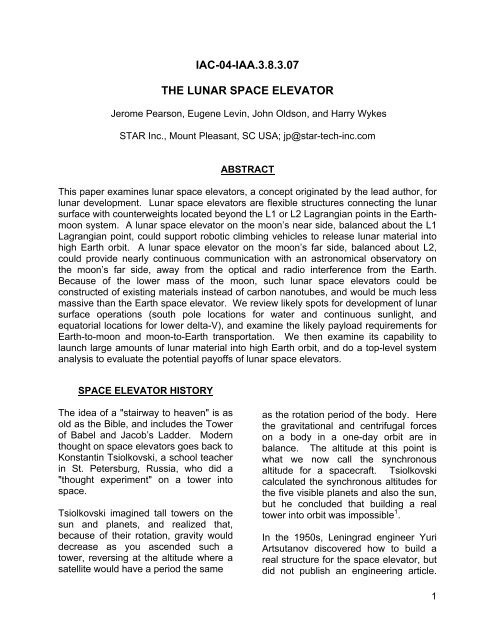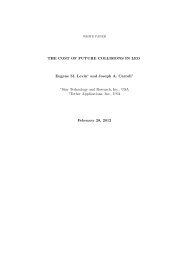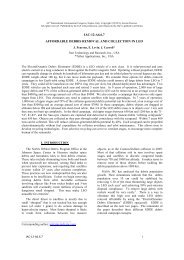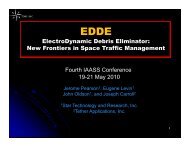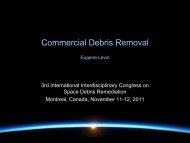IAF 04 Paper - Star Technology and Research
IAF 04 Paper - Star Technology and Research
IAF 04 Paper - Star Technology and Research
Create successful ePaper yourself
Turn your PDF publications into a flip-book with our unique Google optimized e-Paper software.
IAC-<strong>04</strong>-IAA.3.8.3.07<br />
THE LUNAR SPACE ELEVATOR<br />
Jerome Pearson, Eugene Levin, John Oldson, <strong>and</strong> Harry Wykes<br />
STAR Inc., Mount Pleasant, SC USA; jp@star-tech-inc.com<br />
ABSTRACT<br />
This paper examines lunar space elevators, a concept originated by the lead author, for<br />
lunar development. Lunar space elevators are flexible structures connecting the lunar<br />
surface with counterweights located beyond the L1 or L2 Lagrangian points in the Earthmoon<br />
system. A lunar space elevator on the moon’s near side, balanced about the L1<br />
Lagrangian point, could support robotic climbing vehicles to release lunar material into<br />
high Earth orbit. A lunar space elevator on the moon’s far side, balanced about L2,<br />
could provide nearly continuous communication with an astronomical observatory on<br />
the moon’s far side, away from the optical <strong>and</strong> radio interference from the Earth.<br />
Because of the lower mass of the moon, such lunar space elevators could be<br />
constructed of existing materials instead of carbon nanotubes, <strong>and</strong> would be much less<br />
massive than the Earth space elevator. We review likely spots for development of lunar<br />
surface operations (south pole locations for water <strong>and</strong> continuous sunlight, <strong>and</strong><br />
equatorial locations for lower delta-V), <strong>and</strong> examine the likely payload requirements for<br />
Earth-to-moon <strong>and</strong> moon-to-Earth transportation. We then examine its capability to<br />
launch large amounts of lunar material into high Earth orbit, <strong>and</strong> do a top-level system<br />
analysis to evaluate the potential payoffs of lunar space elevators.<br />
SPACE ELEVATOR HISTORY<br />
The idea of a "stairway to heaven" is as<br />
old as the Bible, <strong>and</strong> includes the Tower<br />
of Babel <strong>and</strong> Jacob’s Ladder. Modern<br />
thought on space elevators goes back to<br />
Konstantin Tsiolkovski, a school teacher<br />
in St. Petersburg, Russia, who did a<br />
"thought experiment" on a tower into<br />
space.<br />
Tsiolkovski imagined tall towers on the<br />
sun <strong>and</strong> planets, <strong>and</strong> realized that,<br />
because of their rotation, gravity would<br />
decrease as you ascended such a<br />
tower, reversing at the altitude where a<br />
satellite would have a period the same<br />
as the rotation period of the body. Here<br />
the gravitational <strong>and</strong> centrifugal forces<br />
on a body in a one-day orbit are in<br />
balance. The altitude at this point is<br />
what we now call the synchronous<br />
altitude for a spacecraft. Tsiolkovski<br />
calculated the synchronous altitudes for<br />
the five visible planets <strong>and</strong> also the sun,<br />
but he concluded that building a real<br />
tower into orbit was impossible 1 .<br />
In the 1950s, Leningrad engineer Yuri<br />
Artsutanov discovered how to build a<br />
real structure for the space elevator, but<br />
did not publish an engineering article.<br />
1
His ideas appeared in a Sunday<br />
supplement to Pravda in 1960 2 , <strong>and</strong><br />
their significance was not recognized in<br />
the West. In 1966, a group of<br />
oceanographers led by John Isaacs at<br />
the Scripps Institute re-discovered the<br />
concept, but they proposed such a thin<br />
wire that it would be cut by micrometeoroids<br />
almost instantly, could not<br />
be scaled up, <strong>and</strong> was therefore<br />
completely impractical 3 .<br />
Jerome Pearson discovered the concept<br />
independently <strong>and</strong> published it in the<br />
international journal Acta Astronautica,<br />
<strong>and</strong> thus made the international<br />
aerospace community aware of the<br />
space elevator for the first time 4 , in<br />
1975. An Air Force painting of<br />
Pearson’s space elevator (Fig. 1) shows<br />
Fig. 1: The Space Elevator<br />
capsules moving up <strong>and</strong> down from the<br />
space complex in synchronous orbit.<br />
His discovery included using the space<br />
elevator for zero-net-energy space<br />
launching, <strong>and</strong> for launching payloads<br />
from the elevator tip to reach other<br />
planets without requiring rockets. He<br />
also was first to examine the dynamics<br />
of actually lifting payloads up the<br />
elevator, <strong>and</strong> found limitations on the<br />
speeds of ascent, akin to the critical<br />
velocities of a rotating shaft <strong>and</strong> the<br />
periodic loads from soldiers marching on<br />
a bridge. After talking with Pearson, the<br />
science fiction writer <strong>and</strong> visionary<br />
Arthur Clarke wrote his famous novel<br />
about the space elevator 5 .<br />
Pearson later extended the space<br />
elevator idea to the moon, using the<br />
Lagrangian points as balance points in<br />
lieu of the geostationary orbit, <strong>and</strong><br />
discovered that such a “lunar anchored<br />
satellite” 6 could be used to bring lunar<br />
materials into high Earth orbit cheaply.<br />
Fig. 2 shows an Air Force artist’s<br />
concept of the lunar anchored satellite<br />
with a spacecraft anchored beyond the<br />
L2 Lagrangian point on the far side of<br />
the moon, for communication with a<br />
farside astronomical observatory.<br />
Fig. 2: The L2 Lunar Space Elevator<br />
Interestingly, Artsutanov 7 published a<br />
paper on a lunar space elevator just one<br />
month later than Pearson, without either<br />
author being aware of the other! To<br />
compound the mutual lack of<br />
awareness, Levin points out that the<br />
Russian scientist Ts<strong>and</strong>er conceived of<br />
a lunar space tower 8 in 1910, although<br />
the ideas were not published until 1978.<br />
2
John McCarthy <strong>and</strong> Hans Moravec of<br />
Stanford University had been thinking<br />
about space elevators in the 1970s, <strong>and</strong><br />
seeing the Pearson orbital tower<br />
publication led Moravec to propose<br />
rotating space tethers unconnected to a<br />
planet or moon, for catching <strong>and</strong><br />
throwing space payloads to different<br />
orbits 9 . Artsutanov had also proposed<br />
this concept earlier 10 , but it was not<br />
known to Moravec. Forward 11 also<br />
proposed rotating tethers for cislunar<br />
transportation a decade later, <strong>and</strong><br />
Oldson <strong>and</strong> Carroll showed the cost<br />
savings from tether transport 12 with<br />
short tethers. Pearson 13 showed the<br />
synergism of combining longer tethers<br />
with rockets or guns.<br />
The rotating tethers proposed by<br />
Moravec, <strong>and</strong> by Hoyt <strong>and</strong> Forward 14 as<br />
propulsion systems for transporting<br />
masses to <strong>and</strong> from the moon are beset<br />
with several difficulties. They are based<br />
on momentum exchange tethers,<br />
catching <strong>and</strong> throwing masses from their<br />
tips, <strong>and</strong> touching down instantaneously<br />
at several points on the lunar surface.<br />
This requires precise control of the<br />
tether tip, precise rendezvous with the<br />
target masses, <strong>and</strong> precise catching of<br />
the incoming masses from another<br />
rotating tether.<br />
The low lunar orbit rotating tether’s orbit<br />
must be carefully controlled <strong>and</strong><br />
adjusted to precisely touch the surface.<br />
Also, the rotating tethers require that the<br />
mass flow be balanced between Earth<br />
<strong>and</strong> the moon, or they must make up the<br />
momentum by other means, usually by<br />
solar power <strong>and</strong> electric propulsion.<br />
Finally, the incoming masses are on<br />
hyperbolic orbits, so if a catch is missed,<br />
the payload is lost; there is no second<br />
chance.<br />
In contrast, lunar space elevators are<br />
passive, fail-safe, involve no high-speed<br />
rendezvous catches or throws, are<br />
stabilized by counterweights beyond the<br />
L1 or L2 points, <strong>and</strong> have no need for<br />
balancing the mass flow or for reboosting.<br />
Masses can be carried up or<br />
down the lunar space elevators by<br />
electrically driven, wheeled vehicles,<br />
gripping the ribbon of the space elevator<br />
<strong>and</strong> using solar or beamed laser power 7 .<br />
These cargo carriers would move at a<br />
moderate speed, but provide constant<br />
mass flow, like a pipeline. A robot<br />
station at the top would launch payloads<br />
of radiation shielding, building materials,<br />
<strong>and</strong> finished constructions from the<br />
lunar mine to high Earth orbit. From<br />
there, they could be further moved to<br />
LEO or to the surface of the Earth for<br />
other uses.<br />
One fundamental problem of building<br />
the space elevator is the phenomenal<br />
strength of materials required to support<br />
its mass over the 35,800-km height to<br />
geostationary orbit. Artsutanov <strong>and</strong><br />
Pearson recognized that carbon<br />
"whiskers" representing perfect-crystal<br />
structures, might be one way to achieve<br />
the required strength. When carbon<br />
nanotube structures were discovered, it<br />
was realized immediately by Richard<br />
Smalley at Rice University in Houston,<br />
Texas <strong>and</strong> by Boris Yakobson at North<br />
Carolina State University that these<br />
super-strength materials would make<br />
the Earth space elevator possible.<br />
Because a space elevator is hanging<br />
from stationary orbit, it must support its<br />
own weight over this enormous<br />
distance. In a uniform 1-g gravity field,<br />
a uniform cable of a specific material<br />
can attain a “breaking height” h = σ/ρg,<br />
where σ is the stress limit of the material<br />
3
<strong>and</strong> ρ is its density. Since no material<br />
has a breaking height as high as<br />
synchronous orbit, the space elevator<br />
must be tapered from a maximum at the<br />
synchronous height to minima at the<br />
base <strong>and</strong> at the top.<br />
Table 1 shows c<strong>and</strong>idate materials for<br />
space elevators, with their breaking<br />
heights. The Earth space elevator will<br />
require carbon nanotubes, but lunar<br />
space elevators can be constructed with<br />
these existing materials.<br />
Building<br />
Material<br />
Material<br />
Density<br />
ρ, kg/m 3<br />
Stress<br />
limit<br />
σ, GPa<br />
Breaking<br />
Height<br />
σ/ρg, km<br />
SWCN* 2266 50 2200<br />
T1000G† 1810 6.4 361<br />
Zylon‡ PBO 1560 5.8 379<br />
Spectra¶ 2000 970 3.0 316<br />
M5** 1700 5.7 342<br />
M5 planned 1700 9.5 570<br />
Kevlar†† 49 1440 3.6 255<br />
* Single-wall carbon nanotubes (lab measured)<br />
† Toray carbon fiber<br />
‡ Aramid, Ltd. polybenzoxazole fiber<br />
¶ Honeywell extended chain polyethylene fiber<br />
** Magellan honeycomb-like 3-D polymer<br />
†† DuPont aramid fiber<br />
Table 1: C<strong>and</strong>idate materials<br />
The amount of taper required is an<br />
exponential function of h <strong>and</strong> the radius,<br />
mass, <strong>and</strong> rotation rate of the planet, as<br />
shown in Figure 3. This figure shows<br />
that the Earth space elevator is very<br />
dem<strong>and</strong>ing of materials, but space<br />
elevators for Mars <strong>and</strong> the moon are<br />
much easier.<br />
The space elevator must be constructed<br />
of extremely strong, lightweight<br />
materials, <strong>and</strong> for minimum mass it is<br />
tapered exponentially with of the<br />
planet’s gravity field <strong>and</strong> the<br />
strength/density of the building material.<br />
Using the M5 fiber with their advertised<br />
stress limit of 9.5 Gpa gives a breaking<br />
height of 570 km under 1 g. For the L1<br />
lunar space elevator, this requires a<br />
taper ratio of just 2.66 in cross-sectional<br />
area between the maximum at the L1<br />
point <strong>and</strong> the minimum at the lunar<br />
surface. For Mars <strong>and</strong> Earth, M5 fiber<br />
would require taper ratios of 81 <strong>and</strong><br />
5800, respectively, because of their<br />
higher gravity fields.<br />
Area Taper Ratio<br />
1000<br />
100<br />
10<br />
Moon<br />
Mars<br />
1<br />
100 1000 10000<br />
h, km<br />
Earth<br />
Figure 3: Space elevator area taper<br />
ratios vs. breaking height for<br />
Earth, Mars, <strong>and</strong> the moon<br />
Physicist Bradley Edwards proposed a<br />
practical scheme for constructing a<br />
space elevator about the Earth, <strong>and</strong><br />
received NIAC funding for a study 15 .<br />
The Earth space elevator concept has<br />
now been advanced in the construction<br />
system, the cargo lifting system, <strong>and</strong><br />
especially in materials 16 . However,<br />
there are two very difficult problems to<br />
be overcome in building the Earth space<br />
elevator—the necessity for a material<br />
such as carbon nanotubes, which may<br />
not be available for construction for<br />
decades, <strong>and</strong> the problem of<br />
interference with all other spacecraft<br />
<strong>and</strong> debris in Earth orbit.<br />
4
Because the space elevator is a fixed<br />
structure that extends from the equator<br />
to beyond the geostationary orbit, every<br />
satellite <strong>and</strong> every piece of debris will<br />
eventually collide with it, typically at<br />
greater than orbital velocity. This<br />
means that for safety the Earth space<br />
elevator must be constantly controlled to<br />
avoid these obstacles, or they must be<br />
removed, requiring an enormous space<br />
cleansing.<br />
On the other h<strong>and</strong>, it is possible to build<br />
Pearson’s lunar space elevator now,<br />
<strong>and</strong> use it to develop lunar resources<br />
<strong>and</strong> for lunar farside communication. It<br />
could also be constructed of existing<br />
composite materials, <strong>and</strong> does not<br />
require the super-strength of carbon<br />
nanotubes. Because of the moon’s<br />
lower gravity, far less material would be<br />
required than the Earth space<br />
elevator 17 .<br />
Vision<br />
LUNAR SPACE ELEVATOR<br />
SYSTEM CONCEPT<br />
We propose to develop lunar resources<br />
<strong>and</strong> make them available for large-scale<br />
operations in cislunar space, by using<br />
lunar space elevators. The architecture<br />
for this vision consists of three systems:<br />
a lunar construction system, a lunar<br />
space elevator system, <strong>and</strong> a cislunar<br />
transportation system.<br />
The construction system is a unique <strong>and</strong><br />
streamlined method for creating the<br />
basic building blocks for lunar <strong>and</strong><br />
orbital construction, <strong>and</strong> will be detailed<br />
in a later paper. The lunar space<br />
elevators use both Lagrangian points to<br />
provide access to nearside <strong>and</strong> farside<br />
equatorial regions <strong>and</strong> the polar regions<br />
as well. Solar-powered vehicles climb<br />
the space elevators to take payloads<br />
beyond the Lagrangian points with<br />
excess orbital energy. From there,<br />
small robotic space tugs complete the<br />
cislunar transportation system, taking<br />
lunar materials to high Earth orbit (HEO)<br />
for use in construction, shielding,<br />
habitats, <strong>and</strong> solar power satellites.<br />
The effectiveness of this vision will<br />
depend on the kinds <strong>and</strong> amounts of<br />
material flows that such a system could<br />
support, <strong>and</strong> the potential uses <strong>and</strong><br />
payoffs of the final products for<br />
operations in Earth orbit, as well as the<br />
mass required for the lunar space<br />
elevators compared with the expected<br />
annual throughput.<br />
We have begun to identify the most<br />
likely lunar products for developing <strong>and</strong><br />
industrializing Earth orbit, <strong>and</strong> to define<br />
<strong>and</strong> analyze the space elevator<br />
operating concept, including the cargo<br />
vehicles for carrying lunar materials.<br />
We have also examined taking the lunar<br />
products from the elevator vehicles <strong>and</strong><br />
propelling them into high Earth orbit.<br />
This allows an evaluation of the payoffs<br />
of the entire system for cislunar<br />
development.<br />
Figure 4 shows our concept for lunar<br />
space elevators to develop lunar<br />
resources. Lunar space elevators allow<br />
access to both the equatorial maria <strong>and</strong><br />
the polar mountains, <strong>and</strong> inherently<br />
includes a non-rocket propulsion system<br />
to take the material to HEO.<br />
Two lunar space elevators (LSE) will<br />
meet the needs—one balanced about<br />
the L1 Lagrangian point, <strong>and</strong> one about<br />
the L2 Lagrangian point. L1 is 58,021 ±<br />
3183 km from the center of the moon<br />
5
toward the Earth, <strong>and</strong> L2 is 64,517 ±<br />
3539 km from the center of the moon<br />
away from the Earth. The variations are<br />
due to the 0.055 eccentricity of the lunar<br />
orbit. The L1 LSE is slightly easier to<br />
build <strong>and</strong> is constantly visible from the<br />
TO HEO<br />
EQUATORIAL BASE<br />
L-1<br />
N<br />
TRAMWAY<br />
CARGO CAPSULES<br />
COUNTERWEIGHT<br />
Earth; the L2 LSE is slightly better for<br />
launching masses into Earth <strong>and</strong> lunar<br />
orbits, <strong>and</strong> can communicate with lunar<br />
farside outposts.<br />
COUNTERWEIGHT<br />
POLAR BASE<br />
Figure 4: Lunar space elevators about L1 <strong>and</strong> L2, with equatorial <strong>and</strong> polar bases<br />
Lunar space elevator design<br />
Vertical lunar space elevators balanced<br />
about the L1 <strong>and</strong> L2 Lagrangian points<br />
provide access to the lunar maria on<br />
both the near <strong>and</strong> far sides of the moon.<br />
Providing access to the polar regions<br />
requires multiple attachment points,<br />
multiple ribbons, <strong>and</strong> continuation of the<br />
space elevator across the surface to<br />
reach polar mines for lunar hydrogen.<br />
Finally, launching material into high<br />
Earth orbit without rockets for their most<br />
useful applications requires space<br />
elevator extensions beyond L1 <strong>and</strong> L2.<br />
The complete lunar space elevator<br />
system requires a basic structural<br />
ribbon, climbing vehicles, <strong>and</strong> tramways.<br />
S<br />
L-2<br />
The self-powered climbers carry the<br />
cargo from the construction sites up the<br />
elevators. The tramways connect the<br />
lower ends of the elevator legs to the<br />
polar sites for continuous power <strong>and</strong><br />
hydrogen, the nearside maria for<br />
ilmenite, <strong>and</strong> the farside highl<strong>and</strong>s for<br />
astronomical observatories unaffected<br />
by interference from the Earth’s<br />
electromagnetic radiation.<br />
To access the poles, the space<br />
elevators have non-vertical segments<br />
that curve away from the equator <strong>and</strong><br />
toward the poles, connecting the<br />
resources near the lunar poles with the<br />
transportation system. The maximum<br />
latitude that can be reached is limited by<br />
the material breaking height, which was<br />
6
demonstrated theoretically by one of us<br />
(Levin 18 ). Depending on how close the<br />
space elevator building material allows<br />
the base to be moved toward the pole, a<br />
certain length of tramway will be<br />
required to reach the polar mining base.<br />
The lunar space elevators are built from<br />
the L1 <strong>and</strong> L2 balance points, by<br />
extending the space elevator ribbons<br />
until the lower tips reach the surface at<br />
the equator. Additional ribbon str<strong>and</strong>s<br />
can then be lowered <strong>and</strong> towed by a<br />
surface vehicle toward the poles, <strong>and</strong><br />
anchored at convenient mountain peaks<br />
at the latitude where they are tangent to<br />
the surface. These additional ribbons<br />
not only make the lunar space elevator<br />
redundant <strong>and</strong> fail-safe, but they will be<br />
extended from lunar mountain peak to<br />
peak until they reach mining bases near<br />
the poles. This creates direct<br />
connections between the polar mining<br />
<strong>and</strong> refining bases <strong>and</strong> the launch<br />
stations beyond L1 <strong>and</strong> L2.<br />
Figure 4 shows the total mass of the<br />
ribbon <strong>and</strong> the counterweight required to<br />
balance the L1 lunar space elevator<br />
using the expected values for M5. The<br />
values for L2 are very slightly higher.<br />
If the counterweight is placed just<br />
beyond the L1 point, a very large<br />
counterweight is required to balance the<br />
space elevator ribbon, <strong>and</strong> this gives a<br />
very large total system mass. If the<br />
ribbon is extended much beyond the L1<br />
balance point, the required<br />
counterweight is much smaller, <strong>and</strong> the<br />
total system mass declines. However,<br />
the system mass is dominated by the<br />
counterweight, even out to lengths of<br />
120,000 km.<br />
Mass, kg<br />
1.E+08<br />
1.E+07<br />
1.E+06<br />
Counterweight Mass<br />
Ribbon Mass<br />
Total Mass<br />
1.E+05<br />
60 70 80 90 100 110 120<br />
Height, thous<strong>and</strong>s of km<br />
Figure 4: Lunar space elevator ribbon<br />
<strong>and</strong> counterweight mass<br />
Lunar space elevator construction<br />
A flat ribbon of M5 material, 30 mm wide<br />
<strong>and</strong> only 0.023 mm thick, similar to<br />
aluminum foil, could support a mass of<br />
2000 kg at the lunar surface, or 100<br />
cargo vehicles of 580 kg each spaced<br />
evenly up the length of the elevator<br />
ribbon. The average velocity of the<br />
cargo vehicles might be reasonably<br />
maintained at 100 km/hour for the<br />
ascent, without producing undue wear<br />
on the elevator ribbon.<br />
Climbing vehicles to carry payloads up<br />
to L1 <strong>and</strong> L2 could grip the ribbonshaped<br />
lunar space elevator, as shown<br />
in Figure 5. The climbers would be<br />
equipped with large wheels that press<br />
against the ribbon of the space elevator<br />
from both sides, providing enough<br />
frictional force to support the weight of<br />
the payload.<br />
7
Figure 5: Climbing vehicles grip the<br />
ribbon, vertically or horizontally<br />
With this climbing vehicle mass <strong>and</strong><br />
speed, the resulting Coriolis force on the<br />
ribbon would total just 7.9 N for 100<br />
vehicles, or less than 0.02% of the<br />
tension. This speed is also less than<br />
1% of the transverse wave velocity, <strong>and</strong><br />
therefore the vehicles will not excite the<br />
ribbon flexible modes.<br />
Maintaining this velocity would require<br />
26 kW at the surface, but would halve at<br />
600 km height, <strong>and</strong> halve again at 1741<br />
km. One-fourth of the way to L1 the<br />
power would be down to 290 W. Most<br />
of the journey would require very little<br />
power, <strong>and</strong> so the capsules might have<br />
less than 1 kW of solar array capacity,<br />
allowing for losses from efficiency of<br />
sunlight on the single-axis-control of the<br />
hanging arrays. Their initial acceleration<br />
could be provided by laser power<br />
beamed at much higher than solar<br />
power density from a surface laser, or<br />
they could simply start at lower speed.<br />
Lunar space elevator operations<br />
Lunar mining, refining, <strong>and</strong> construction<br />
plants will be built on the surface, with<br />
useful objects constructed from lunar<br />
resources, carried up the lunar space<br />
elevators by solar-powered cargo<br />
capsules, <strong>and</strong> dropped from the tip of<br />
the space elevator into high Earth orbit<br />
for use in the next phase of space<br />
development. Lunar space elevators<br />
will revolutionize the way we operate in<br />
cislunar space, <strong>and</strong> will greatly reduce<br />
the cost of getting lunar materials into<br />
Earth orbit.<br />
The lunar space elevator will also be a<br />
stepping stone to the Earth space<br />
elevator. Lunar space elevators do not<br />
require super-strength materials, <strong>and</strong> do<br />
not endanger all Earth satellites. Lunar<br />
space elevators are twice the length of<br />
the Earth space elevator, but because of<br />
the moon’s much smaller mass they can<br />
be constructed of existing materials. In<br />
addition, there are few satellites in lunar<br />
orbit, no man-made debris, <strong>and</strong> fewer<br />
meteoroids are expected. The Earth<br />
space elevator <strong>and</strong> the lunar space<br />
elevator both need traveling vehicles to<br />
carry cargo along their ribbons of<br />
material, <strong>and</strong> they are both orders of<br />
magnitude longer than any structure yet<br />
constructed in space. For these<br />
reasons, the lunar space elevator is an<br />
excellent testbed for examining many of<br />
the technology challenges of the Earth<br />
space elevator, including the dynamics<br />
<strong>and</strong> stability of long structures in space,<br />
control of the lateral <strong>and</strong> longitudinal<br />
oscillations, <strong>and</strong> vehicles climbing<br />
rapidly along their great lengths.<br />
Lunar space elevators will provide<br />
abundant raw materials <strong>and</strong><br />
manufactured products that can be<br />
continuously delivered into Earth orbit<br />
for development of extensive space<br />
facilities, space stations, space hotels<br />
<strong>and</strong> tourism centers, space power<br />
stations <strong>and</strong> manufacturing facilities.<br />
The use of lunar material, without the<br />
heavy burden of lifting the material out<br />
8
of the Earth’s deep gravity well, will<br />
allow the production of power <strong>and</strong><br />
materials without encroaching on the<br />
Earth’s biosphere, <strong>and</strong> could provide<br />
attractive <strong>and</strong> radiation shielded<br />
destinations in cislunar space. The use<br />
of lunar hydrogen could also provide<br />
propellant to greatly reduce the cost of<br />
expeditions to Mars.<br />
The chart shown here, reproduced from<br />
Pearson (Reference 6), shows the halfregions<br />
of accessible orbits from the<br />
lunar space elevators.<br />
L5<br />
Moon Earth<br />
Figure 6: Accessible regions in the<br />
Earth-moon space from payloads<br />
released from the L1 <strong>and</strong> L2 points<br />
Payloads carried up the lunar space<br />
elevator <strong>and</strong> released beyond L1 or<br />
inside L2 could reach the inner hatched<br />
region of Figure 6; payloads released<br />
from beyond L2 could reach the outer<br />
hatched region. Basically, the<br />
accessible regions cover all of cislunar<br />
space except an extended region<br />
encompassing the Lagrangian points<br />
L3, L4 <strong>and</strong> L5.<br />
If the L1 lunar space elevator is<br />
extended far enough, payloads released<br />
from the top would fall into lower Earth<br />
orbits—the longer the L1 lunar space<br />
elevator, the lower the Earth orbit<br />
perigee.<br />
Figure 7 shows the perigee of typical<br />
Earth orbits reached by payloads<br />
released from the L1 lunar space<br />
elevator. The L1 point is 58,000 km<br />
from the lunar surface, or about 0.15<br />
lunar distance units. If the payload is<br />
released from 130,000 km high, its HEO<br />
perigee will reach GEO. This should be<br />
the limit, because any lower would<br />
interfere with geostationary satellites.<br />
Orbit radius, lunar orbit units<br />
1.00<br />
0.75<br />
0.50<br />
0.25<br />
Perigee<br />
Apogee<br />
GEO Altitude<br />
0.00<br />
0.15 0.25 0.35 0.45<br />
Release point on L1, lunar orbit units<br />
Figure 7: High Earth orbits<br />
reached by payloads from the L1<br />
lunar space elevator<br />
Lunar Space Elevators for Cislunar<br />
Development<br />
The construction of lunar bases <strong>and</strong><br />
habitats using lunar resources 19 was<br />
considered extensively in the 1970’s<br />
after the Apollo missions provided<br />
information about the composition of<br />
lunar maria <strong>and</strong> highl<strong>and</strong>s. The lunar<br />
materials available include the basaltic<br />
lavas of the nearside maria, with their<br />
silicates <strong>and</strong> iron-titanium oxide<br />
ilmenites, <strong>and</strong> the feldspars of the<br />
highl<strong>and</strong>s. More recently, the<br />
Clementine <strong>and</strong> Lunar Prospector<br />
9
missions have shown the likely<br />
presence of lunar hydrogen in<br />
permanently shadowed areas near the<br />
south pole, probably as water ice. The<br />
lunar space elevators provide a means<br />
to develop all these resources.<br />
The poles may be the key to lunar<br />
resource development. The Clementine<br />
<strong>and</strong> Lunar Prospector missions<br />
indicated that there may be valuable<br />
deposits of water ice in permanently<br />
dark craters near the poles. These<br />
could be invaluable as a source of<br />
rocket propellant for propulsion in<br />
cislunar space. There are also<br />
permanently sunlit mountain peaks near<br />
the lunar south pole, allowing for the<br />
generation of continuous solar power,<br />
even through the 14-day lunar night.<br />
This could greatly assist a mining base<br />
near the south pole.<br />
The lunar space elevator allows us to<br />
re-discover the moon for space habitats,<br />
after the romance in the 1970s with<br />
space colonies at L4 <strong>and</strong> L5. With<br />
virtually continuous solar power from<br />
mountain peaks, <strong>and</strong> valleys of<br />
permanent darkness for mining<br />
condensed ices, the poles provide a<br />
range of lunar resources. The moon<br />
also provides a constant gravity force to<br />
keep the muscles, bones, <strong>and</strong> vestibular<br />
systems of the inhabitants in better<br />
shape while requiring less exercise than<br />
the zero gravity of space stations.<br />
Mining lunar regolith <strong>and</strong> launching it<br />
from beyond L1 using a constant stream<br />
of climbing vehicles on the lunar space<br />
elevator could provide a total throughput<br />
of more than 755,000 kg of material per<br />
year into high Earth orbit.<br />
CONCLUSIONS<br />
The lunar space elevator can be a key<br />
piece in the development of the moon<br />
<strong>and</strong> the use of its resources for<br />
advanced space development, <strong>and</strong> it<br />
can contribute greatly to the new vision<br />
for a moon-Mars initiative announced by<br />
President Bush in January of 20<strong>04</strong>. We<br />
expect lunar space elevators to enable<br />
us to take advantage of these positive<br />
attributes by creating a paradigm shift<br />
leading to bold moves for lunar<br />
development, sending humans to Mars,<br />
<strong>and</strong> on into the solar system.<br />
REFERENCES<br />
1 Pearson, J., "Konstantin Tsiolkovski <strong>and</strong> the<br />
Origin of the Space Elevator," <strong>IAF</strong>-97-IAA.2.1.09,<br />
48th <strong>IAF</strong> Congress, Torino, Italy, October 6-10,<br />
1997.<br />
2 Artsutanov, Yuri, "V Kosmos na Electrovoze”<br />
(in Russian, Into Space on a Train),<br />
Komsomolskaya Pravda, July 31 1960.<br />
3 Isaacs, J., Vine, A. C., Bradner, H. <strong>and</strong> Bachus,<br />
G. E., "Satellite Elongation into a true Sky-Hook,"<br />
Science 151, 682-683, 1966.<br />
4 Pearson, Jerome, “The Orbital Tower: A<br />
Spacecraft Launcher Using the Earth's Rotational<br />
Energy,” Acta Astronautica, Vol. 2, pp. 785-799,<br />
Sep/Oct 1975.<br />
5 Clarke, A. C., The Fountains of Paradise,<br />
Harcourt Brace Jovanovich, New York, 1979.<br />
6 Pearson, Jerome, “Anchored Lunar Satellites for<br />
Cislunar Transportation <strong>and</strong> Communication,”<br />
Journal of the Astronautical Sciences, Vol.<br />
XXVII, No. 1, pp. 39-62, Jan/Mar 1979.<br />
10
7 Artsutanov, Yuri, “The Earth-to-Moon<br />
Highway,” (in Russian), Technika-Molodyegi, No.<br />
4, 21, 35, 1979.<br />
8 Ts<strong>and</strong>er, F., Selected <strong>Paper</strong>s (in Russian),<br />
Zinatne, Riga, 1978.<br />
9 Moravec, H., "A Non-Synchronous Rolling<br />
Skyhook," Journal of the Astronautical Sciences<br />
25, 307-322, 1978.<br />
10 Artsutanov, Y., "Into the Cosmos without<br />
Rockets," Znanije-Sila 7, 25, 1969.<br />
11 Forward, R. L., "Tether Transport from LEO<br />
to the Lunar Surface," AIAA <strong>Paper</strong> 91-2322, 27th<br />
Joint Propulsion Conference, Sacramento, CA,<br />
June 1991.<br />
12 Oldson, J. <strong>and</strong> J.A. Carroll, "Potential Launch<br />
Cost Savings of a Tether Transport Facility,"<br />
AIAA 95-2895, Joint Propulsion Conference, San<br />
Diego, July 1995.<br />
13 Pearson, Jerome, “Low-Cost Space Launcher<br />
<strong>and</strong> Orbital Fuel Depot,” Acta Astronautica, Vol.<br />
19, No. 4, pp. 315-320, 1989.<br />
14 Hoyt, Robert, <strong>and</strong> Chauncey Uphoff, “Cislunar<br />
Tether Transport System,” 35th Joint Propulsion<br />
Conference, AIAA 99-2690, Los Angeles, CA, 20-<br />
24 June 1999.<br />
15 Edwards, Bradley C., "Design <strong>and</strong> Deployment<br />
of a Space Elevator," Acta Astronautica, Vol. 47,<br />
2000, p. 735.<br />
16 Edwards, Bradley C. <strong>and</strong> Westling, Eric A.,<br />
The Space Elevator, published by Edwards &<br />
Westling, January, 2003.<br />
17 Pearson, J., "Lunar Anchored Satellite Test,"<br />
AIAA <strong>Paper</strong> 78-1427, August 1978.<br />
18 Beletsky, V. V., <strong>and</strong> Levin, E. M., “Dynamics<br />
of Space Tether Systems,” Advances in the<br />
Astronautical Sciences, Vol. 83, American<br />
Astronautical Society, Springfield, VA, 1993.<br />
19 Billingham, John, William Gilbreath, <strong>and</strong><br />
Brian O’Leary, eds., Space Resources <strong>and</strong> Space<br />
Settlements, NASA SP-428, 1979.<br />
11


